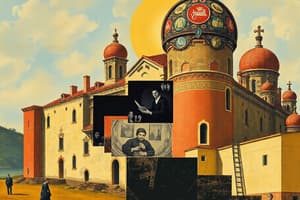Podcast
Questions and Answers
What was the main passion shared by Impressionistic artists?
What was the main passion shared by Impressionistic artists?
- Creating smoothly blended details on the canvas
- Capturing the intensity and change of colors in light (correct)
- Emphasizing dark shadows and gray skies
- Working with slow, deliberate brushstrokes
What was a crucial invention that facilitated the Impressionism movement?
What was a crucial invention that facilitated the Impressionism movement?
- French Box Easel (correct)
- Portable paint boxes
- Traditional studio easels
- Telescopic wooden frames
How did Impressionist artists differ from traditional outdoor painters?
How did Impressionist artists differ from traditional outdoor painters?
- They used slow, deliberate brushstrokes to paint outdoors
- They worked en plein aire to capture a moment in time (correct)
- They focused on smoothly blending details in their paintings
- They sketched partial images and completed them in the studio
Who painted a series of different effects of the Rouen Cathedral?
Who painted a series of different effects of the Rouen Cathedral?
Which artist focused on depicting ballet dancers and horse racing?
Which artist focused on depicting ballet dancers and horse racing?
Who was the only American in the Impressionist group?
Who was the only American in the Impressionist group?
What invention revolutionized the way artists stored and used paint?
What invention revolutionized the way artists stored and used paint?
Where did the Impressionists hold their shows from 1874 to 1886?
Where did the Impressionists hold their shows from 1874 to 1886?
What did Monet's purchase of a property in Giverny lead to?
What did Monet's purchase of a property in Giverny lead to?
What was a common theme in Mary Cassatt's paintings of women?
What was a common theme in Mary Cassatt's paintings of women?
What function was afternoon tea considered for women in the upper or upper-middle classes?
What function was afternoon tea considered for women in the upper or upper-middle classes?
What did Mary Cassatt frequently use as subjects in her paintings?
What did Mary Cassatt frequently use as subjects in her paintings?
What was the significance of the vase of flowers in Cassatt's painting 'The Cup of Tea'?
What was the significance of the vase of flowers in Cassatt's painting 'The Cup of Tea'?
What activity is depicted in 'In the Loge' by Mary Cassatt?
What activity is depicted in 'In the Loge' by Mary Cassatt?
How did Cassatt's figure behave at the opera, as described in the text?
How did Cassatt's figure behave at the opera, as described in the text?
Flashcards are hidden until you start studying
Study Notes
The Invention of the Paint Tube and the Impressionist Movement
- John Goffe Rand invented the paint tube in 1841, revolutionizing the way artists stored and used paint.
- The paint tube preserved the paint's fluidity and was easily removable in small amounts, a vast improvement from previous storage methods.
- The Paris Salon's rejection of a set of artists in 1863 led to the independent artists creating their exhibitions, giving rise to the Impressionist movement.
- The Impressionists held their shows from 1874 to 1886, apart from the Salon and its traditional standards.
- Claude Monet, born in 1840 in France, was a prolific painter and a founder of Impressionism.
- Monet's work focused on landscapes, scenes of the Normandy coast, and the activities of people in Paris.
- Monet frequently worked with other painters, capturing the same panoramas in different seasons and times of the day.
- Monet's purchase of a property in Giverny in 1883 led to the transformation of an old apple orchard into a spectacular garden.
- Monet's water garden in Giverny became his masterpiece, featuring water lilies, a Japanese bridge, and diverse vegetation.
- Monet spent twenty years painting all aspects of the lily pond and its environs, resulting in over 250 images of water lilies.
- Monet's Haystacks series, including "Haystacks (Effect of Snow and Sun)" and "Haystacks Midday," showcased his fascination with capturing the same subject in different lighting and seasonal conditions.
- The Impressionist movement, fueled by innovations like the paint tube and the unique artistic vision of painters like Monet, forever changed the course of art history.
Studying That Suits You
Use AI to generate personalized quizzes and flashcards to suit your learning preferences.




